My passion is for delving back into history and uncovering the origins of the classic French dishes and desserts, discovering the authentic versions and how these iconic foods evolved over time. French onion soup, a dish traditionally eaten after a night of revelry as a nourishing restorative, is the perfect recipe to share with you for New Year’s Eve. Have a safe, happy, and healthy new year!
Onion soup might very well be the single most emblematic dish of the French culinary repertoire. But to those living outside of France, it might also be the most misunderstood and misinterpreted dish of French cuisine.
Traditionally, French onion soup - soupe à l'oignon - is a poor man’s dish based on one simple, common ingredient available to everyone pretty much everywhere: the onion. Onions are cooked in a little fat, butter, oil, or lard, depending on the region, until soft, pale, and translucent, sometimes cooked until a deep golden brown but rarely caramelized. The soft onions are then simmered in water, seasoned with salt and pepper, creating a light but flavorful broth. This broth laden with meltingly tender onions is poured over croutons made from leftover stale bread browned in or grilled with more fat. It is to this day, for the average French family, what it originally was, an easy, cheap, satisfying, homey meal. Contrary to too many recipes found in American food columns, cookbooks, and Julia Child’s Mastering the Art of French Cooking, French onion soup doesn’t need to be nor is it traditionally gussied up with fancy, more costly ingredients like meat stock, wine, cognac, sherry, porto or vermouth to be fantastic. It’s pure comfort food.
And the signature gooey cheese that tops the soup? A very recent, most likely a 19th century Parisian bistro addition to the simple, delicately oniony broth, transforming soupe à l'oignon into soupe à l'oignon gratinée.
Legend has it that this humble dish was invented by King Louis XV in the 18th century: upon returning to his hunting lodge late one night and being overcome by a ravenous hunger, he threw together the only ingredients he could find in the kitchen: onions, butter, and champagne, simmering the 3 together to create a satisfying meal.
A more realistic version of the story - who believes that Louis XV would cook for himself and who could imagine anyone making soup with Champagne, am I right? - begins with the former King of Poland, Duke of Bar and Lorraine, and father-in-law of Louis XV, Stanislas Leszczynski, bon vivant and notable gourmand. Stanislas apparently discovered this “delicate and refined” soup at an inn in Châlons-en-Champagne while en route to Versailles to visit his daughter Marie. He loved it so much, legend has it, that he had it made for the Court where it quickly became quite popular among the upper crust, quickly spreading across Paris and then across France, transforming the status of this once and otherwise unpretentious, poor man’s dish into fashionable fare.
But the origins of this iconic dish began much, much earlier and much more modestly. This soupe des pauvres, poor man’s soup, has been around since antiquity; evidence can be traced back to Roman times when onions were in abundance, being both easy and cheap to cultivate. Everyone could simmer onions with water and it made a nourishing and filling soup.
But once soupe à l'oignon hit the royal court and Parisian homes and restaurants, it also began appearing in French cookbooks where we see that onion soup, sans cheese, was prepared in various forms, yet always quite simply, sometimes even as a restorative or as a curative, a “health soup”. Onions were cooked in a little fat, water was added, and the resulting broth served over grilled bread. A richer version of the soup was made with milk replacing the water or thickened with the addition of eggs or eggs and cream. Occasionally, but rarely, one does find a version made with a light meat and vegetable broth. And while the onions are never caramelized, recipes sometimes suggest either cooking them until a golden brown color or adding flour to the butter-softened onions and cooking slowly until the resulting roux darkens, adding both color and flavor to the broth.
And while we’ve become accustomed to digging our spoons into a single, thick, large slice of bread taking up much of the space in the soup bowl, croutons were often smaller pieces of grilled bread either layered in the bowl or stirred into the onions during cooking and allowed to color and thicken the mix. In his mid-to-late 19th century cookbook Nouvelle Cuisine Bourgeoise, chef Urbain Dubois includes a version with the addition of cheese, although he sprinkles a mix of Parmeson and Gruyere between layers of grilled croutons before pouring the prepared onion soup on top… there was no thick, gooey topping of melted cheese. This is also one of the 2 versions in my 1939 La Cuisine Moderne, the other version being simply onions, salt, milk, and grilled bread.
(Just a curious sidenote: my 1934 edition of Larousse Gastronomique has no recipe at all for onion soup; my 1984 edition - remember, the 80s were the years of cheesy soupe à l'oignon gratinée popularity - does have a recipe but without any cheese at all.)
It was only with its popularity hitting the general public, the Parisian public, that onion soup in France began to find its modern self. End of the 19th/early 20th century, it quickly became a standard late night offering in the restaurants that stayed open around Paris’ famed Les Halles market where workers would finish their day in the wee hours of the morning and pop into an eatery for nourishment. Soon, they would be joined by late night revelers, drunks, and night owls wandering the city and, as onion soup had the reputation of being a hangover remedy as well as having the advantage of covering the odor of “excessive alcohol consumption”, it soon earned the nickname la soupe des ivrognes, the soup of drunks.
But French onion soup in its simplest form had long had the reputation of being a nourishing restorative. It’s a mystery exactly when it started, but for centuries carrying onion soup to a newly married couple was, and still is, tradition. After a long night of festivities, the newlyweds would slip away to a secret place to consummate the marriage. The wedding guests would then go in search of the couple and, upon discovering them, offer onion soup served in a chamber pot! A boisterous, joyous moment of conviviality shared between the bride and groom and their closest family and friends. But after a long day of alcohol-laden merrymaking, the onion soup also purportedly had the magical effect of covering up the bad smells of the wine drunk during the celebrations and reviving the young couple and fortifying them for their night of wedded bliss.
But the 19th century brasserie and bistro owners in Paris’ only neighborhood still bustling with activity after the rest of the city had gone to sleep knew that les forts des Halles - the “strongmen” of the Halles market, the porters, vendors, laborers - the cops on the beat, and the fêtards stumbling out of Paris’ cabarets and dance halls needed more than just a simple restorative. They needed a meal. And so they began serving up steaming bowls of soup rich with beef broth, laden with onions, and dense with bread, the whole piled high with a mountain of grated cheese which was pushed under a grill to melt and brown, turning a simple soup into a classic, where soupe à l'oignon earned the moniker La Gratinée des Halles.
Although I have come to love a great brasserie onion soup, when I am at home cooking for my French family, I return to tradition and make this lighter, more delicate, but every bit as flavorful and satisfying version. It’s easier and more straightforward (not to mention cheaper) to prepare than the more luxurious restaurant or American magazine version. It’s also meat-free and alcohol free, and easy to turn into a vegetarian or vegan meal.
And honestly, it never ceases to amaze me how very good this soup is in its most simple form.
A very traditional authentic French onion soup (Soupe à l’Oignon)
Serves 4 once or 2 twice
4 large yellow or pink (the larger yellow onions with a pink tinge) onions, about 2 pounds/1 kg
About 4 tablespoons (60 grams) butter and 1 - 2 tablespoons olive oil, optional
1 rounded tablespoon flour, optional
Ground nutmeg, salt, freshly ground black pepper
6 cups (1 ½ liters) water, a little more as needed or desired
4 slices stale bread or 8 slices baguette, each slice about ½ to ¾-inch thick
5 ½ to 7 ounces (150 to 200 grams) grated hard cheese, comté, gruyère, emmenthal, or a ewe’s milk tomme, something flavorful and nutty
You will need a large heavy pot to cook the onions, a large frying pan to make the croutons, and an ovenproof pot (I use a 9-inch wide x 3 ½-inch deep (23 x 9-cm) terra cotta risotto dish) or 4/5 individual ovenproof soup bowls.
Peel and thinly slice the onions. Melt about 2 tablespoons butter or a blend of butter and olive oil in a large pot. Add the onion slices and cook over medium heat for 20 to 25 minutes, stirring constantly - it’s imperative to stir constantly so the onions don’t burn. - until very tender.
Sprinkle on the flour - this is optional and only serves to help the onions color as well as thicken the soup - and continue cooking several minutes until the onions begin to color.
Generously salt and pepper the onions and dust on a good pinch or two of ground nutmeg.
Add the water, stir, bring up to a boil, then lower the heat slightly and allow the soup to cook on a high simmer/low boil for 20 minutes. This will create the broth. Add more water if needed.
While the soup is simmering, make the croutons. If using larger slices of bread from a loaf, cut each large slice into 4 pieces. Melt 2 tablespoons butter in a frying pan or skillet. When sizzling, add the slices of bread and cook, pressing the slices for even browning, and fry until the bottom side is a nice golden brown. Flip over the pieces, add more butter to the pan if needed, and cook until the other side of each slice is golden brown as well.
Remove the pan from the heat and lift the croutons out of the frying pan and place in the ovenproof pot.
Preheat the broiler of your oven.
After 20 minutes or so, taste the onion broth and add more salt and/or pepper as needed. Ladle the onions evenly over the croutons then pour over the soup. Cover the top evenly and generously with the grated cheese. Place under the broiler until the cheese is melted and browned.
Serve hot.
NOTE:
Obviously, you can replace some of the water with a dry white wine or vegetable, beef, or chicken stock, or you can caramelize the onions but honestly, it’s not necessary. My version is simple yet fabulous. And even better reheated (even in the microwave!!) the next day. Feel free to add a little bleu (blue cheese) to the comté or gruyère cheese you top the soup with.
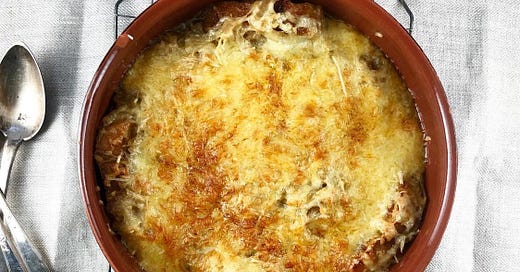



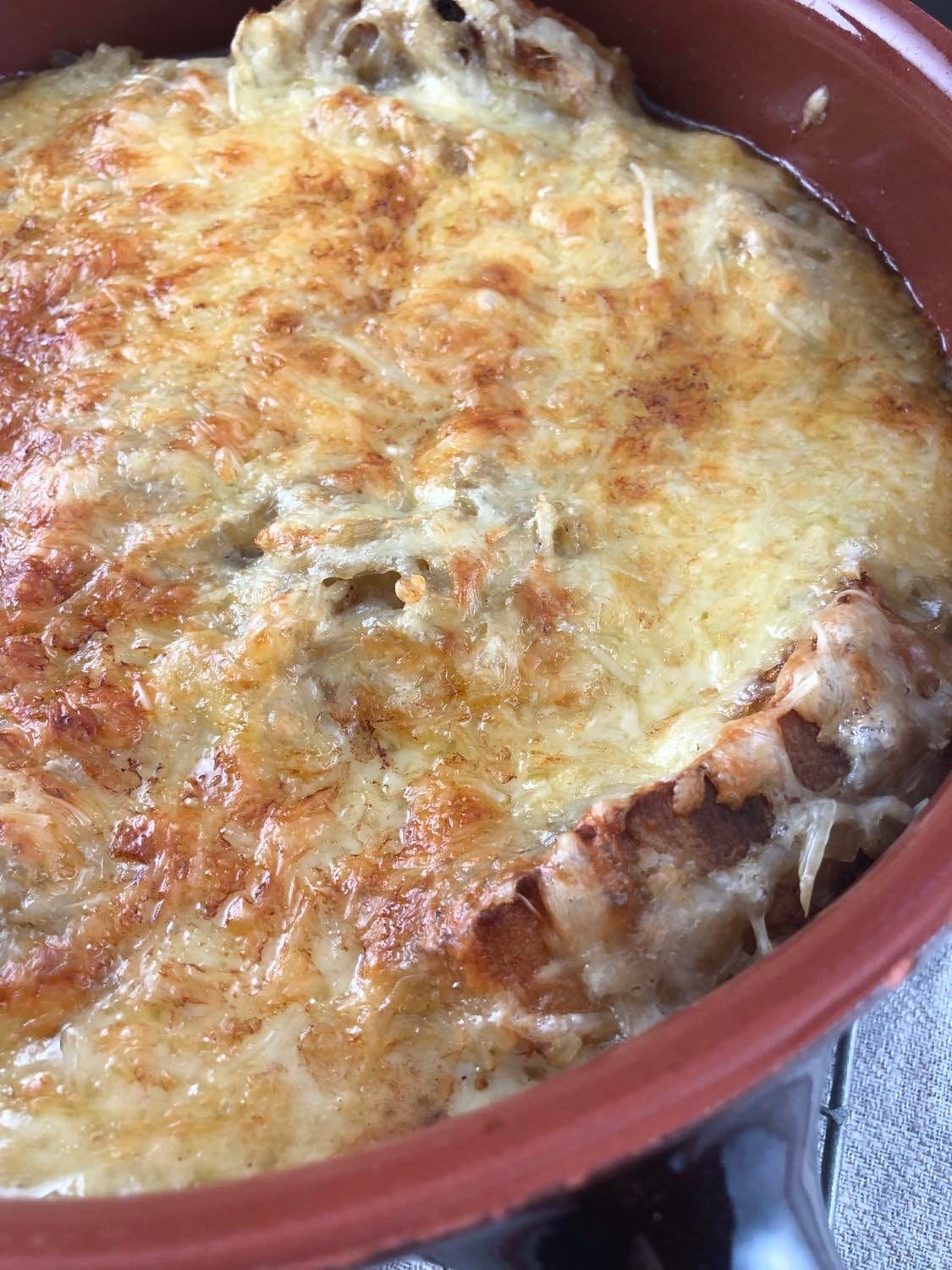

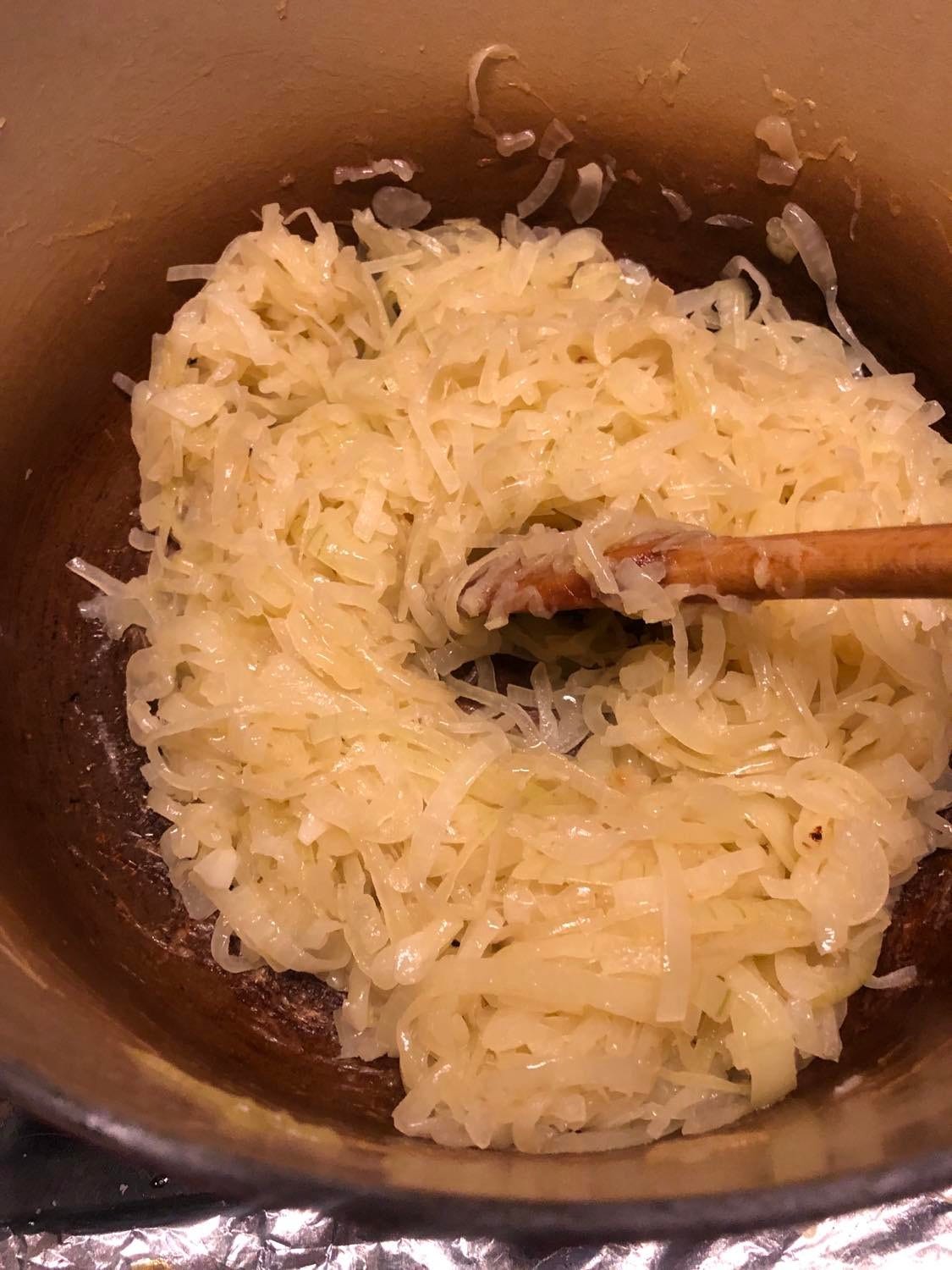


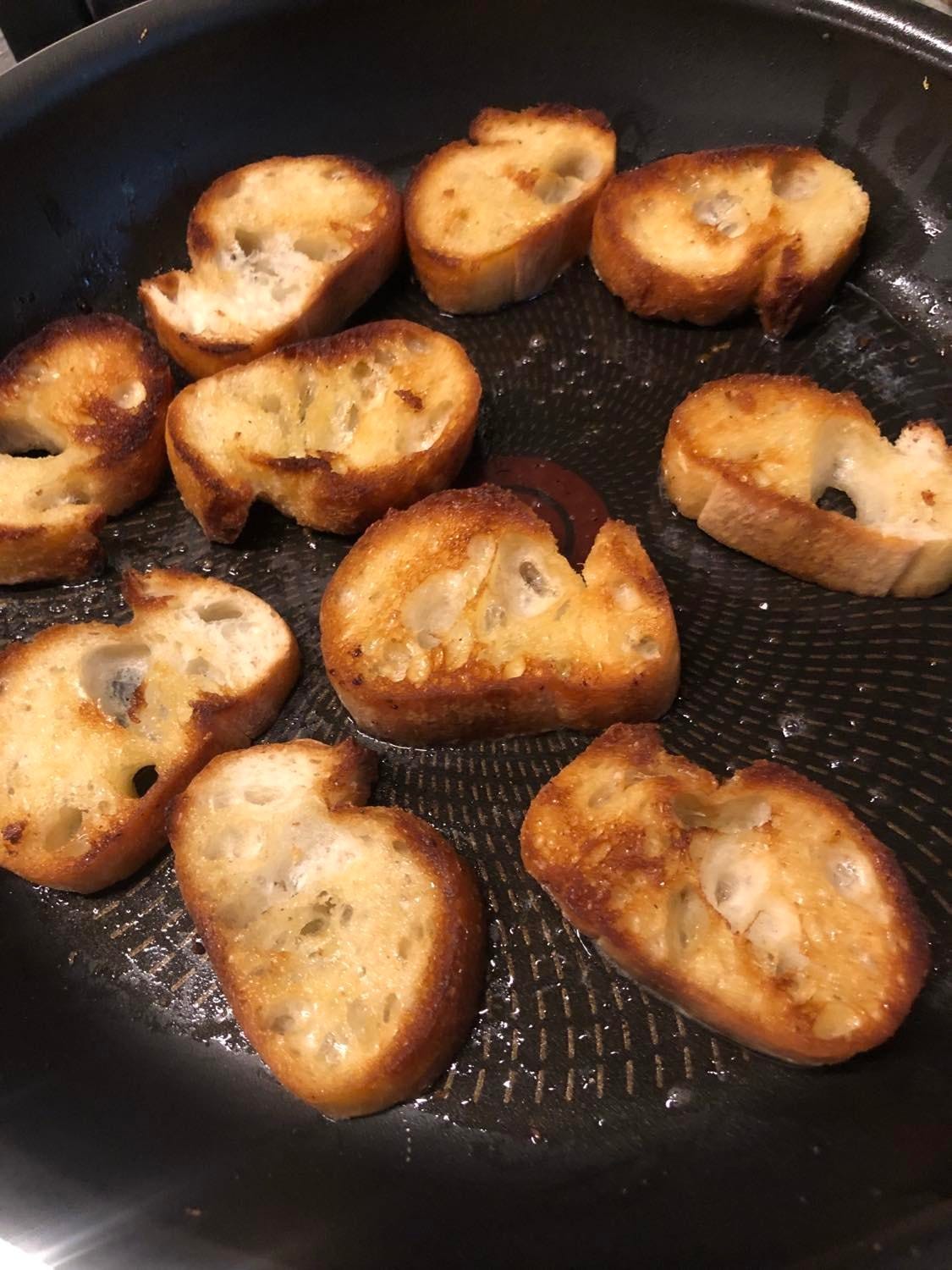
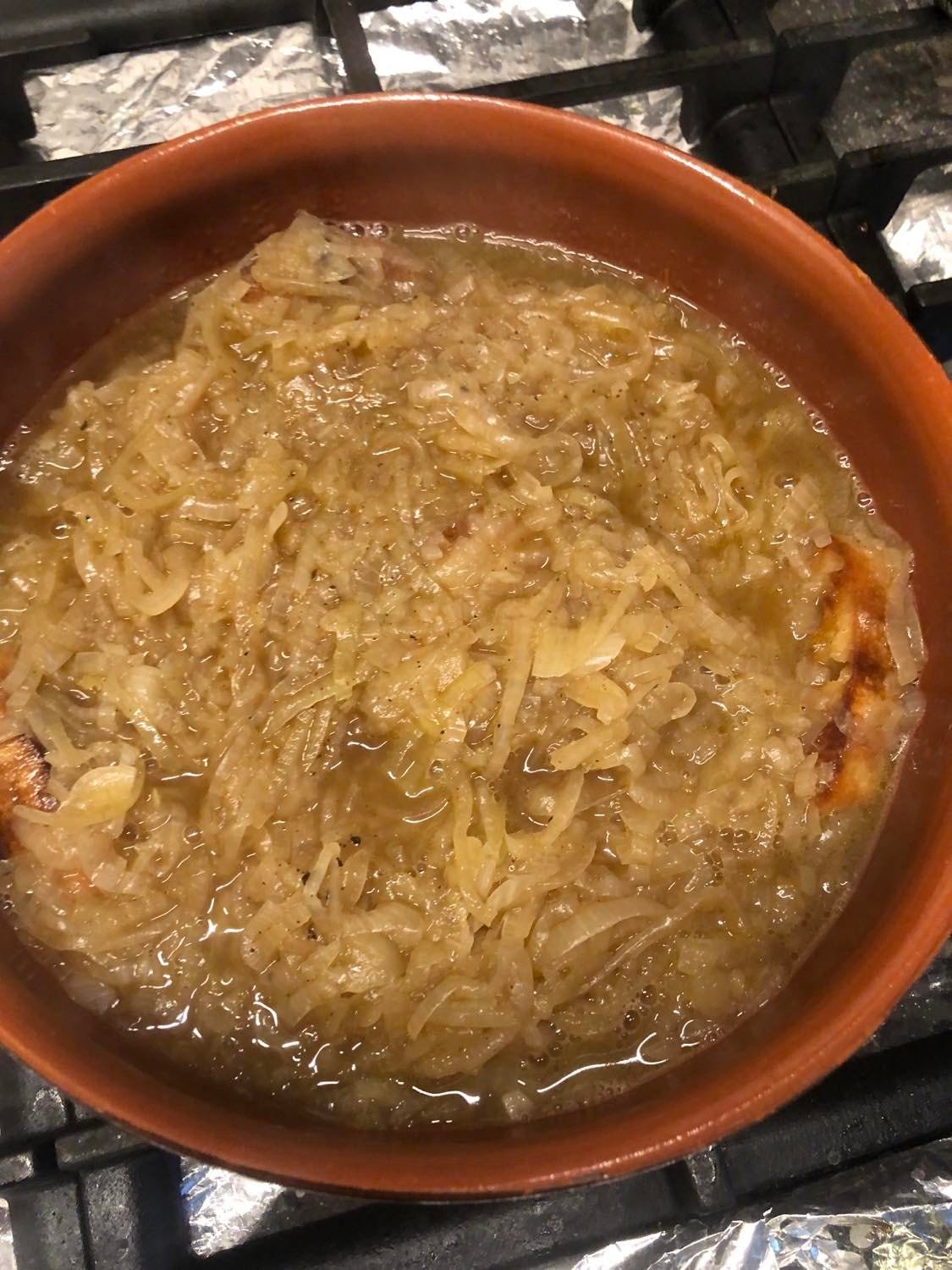

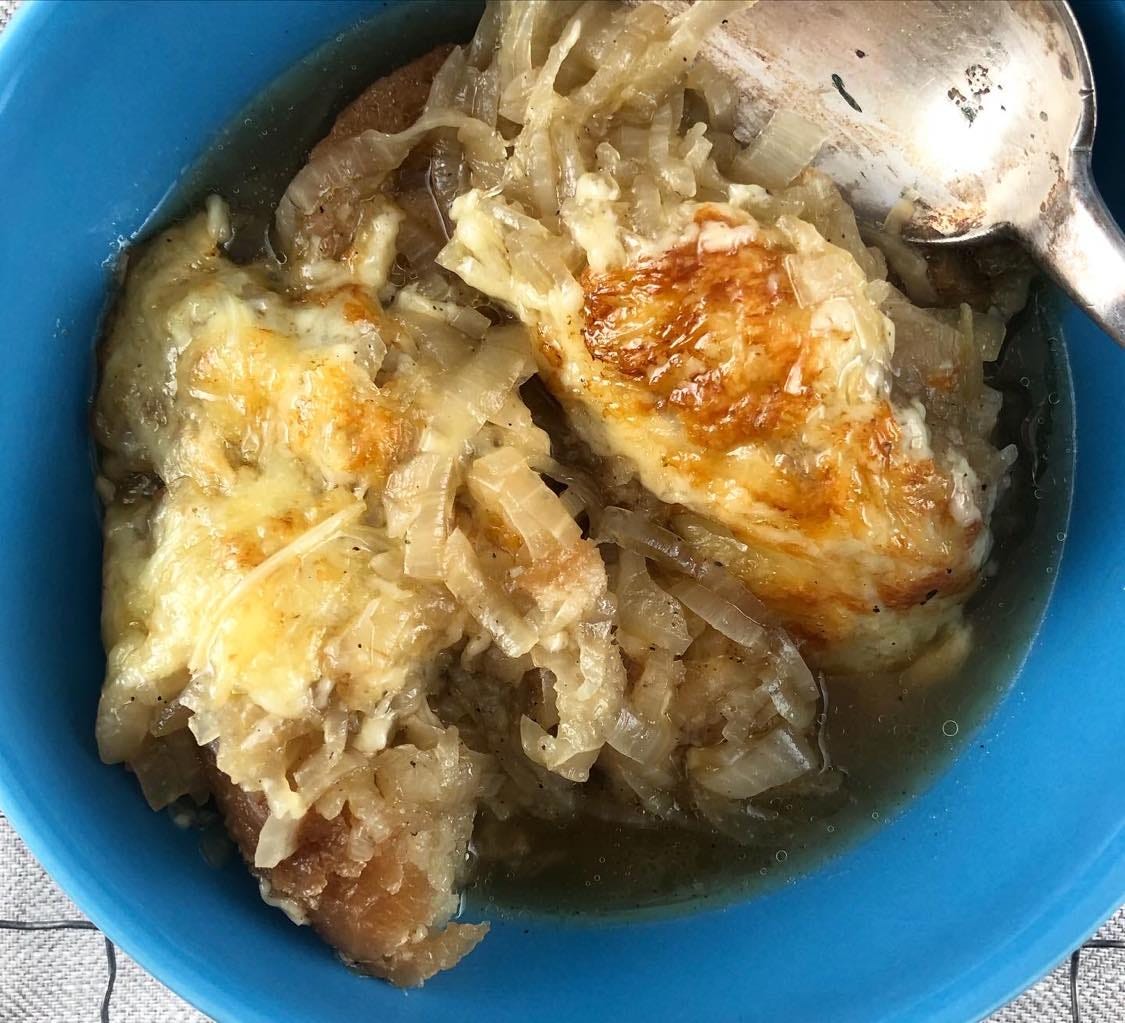
This is the perfect soup, and now I know its history! Making it this weekend. Thank you
Love the history and tradition. Will be sharing a recipe for Italian onion soup (not unlike your pared down version here) in my next newsletter. Great minds and all...Buon anno nuovo! xo